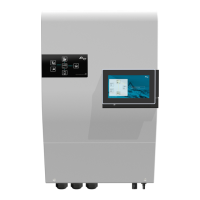Studer Innotec SA
next3
Technical user manual V1.3 © Studer-Innotec SA 79
The 4 cases description, defined by those two questions are:
• Use of battery for solar self-consumption optimization until a state of charge (SOC) for Back-
Up. During the night, the battery is discharged until the given SOC. Under the defined SOC
level, a reserve is left in case of blackout. The default level is 20% to use 80% of the battery as
buffer for lithium batteries and 50% for lead acid batteries. During the day, when the solar
power is produced, that energy is used to supply the AC loads, charge the battery
and inject
the excess energy to the grid.
• Full grid feeding: In this situation, the battery is kept full to be ready in case of blackout. The
SOC for back-up is 100%. All the solar power produced supply the loads and the excess is
injected to the grid.
• Solar priority with zero export. The solar power is used to charge the battery and to supply the
loads but is never sent back to the AC-source. In that mode the grid-feeding is not allowed.
The battery is used as buffer. When there is more solar than loads, the excess will charge the
battery. When the loads are higher than the production, the energy is taken first from the
battery. Only when it is at the lower threshold (SOC for Backup) the grid will be used. Like that,
there is still some energy left in the battery to run some loads when a blackout happens. When
the battery is full and the load is small, the MPPTs will reduce the production, causing some
solar energy to be lost.
• Offgrid or Weak grid: AC-source is a genset or a grid where the injection is forbidden. The
battery is charged to the maximum as soon as the AC source is present ensuring to have
energy available in the next blackout event.
Note: in expert mode, it is possible to change the value of the “SOC for backup” setting.

